Sex Slavery in San Francisco’s Chinatown

By B. Alexandra Szerlip
Contributor
10/8/2019

Before 1915, prostitution was legal in the United States. Slavery, however, had been proscribed, by the Thirteenth Amendment, in the wake of the Civil War. In the bachelor enclave of San Francisco’s Chinatown, though, such niceties were ignored. There was far too much money to be made, too many laws easily circumvented, too many innocents (without resources or recourse) ripe for exploitation.
The 1848 discovery of gold at Sutter’s Mill had inspired tens of thousands of Chinese who, desperate to escape civil wars and widespread famine, had crossed the vast Pacific, leaving families, language, and all things familiar behind, to try their luck. The majority hailed from the particularly stricken southern province of Guangdong (Canton). 15 years later, when work on the western half of the Transcontinental Railway began, tens of thousands more “Chinks” and “coolies” were hired, including new “imports,” for the treacherous, backbreaking work. Many of those who survived ended up living in an eight-block, northern California ghetto, not far from San Francisco’s prestigious Nob Hill, where they were easily distinguishable by their dark caps and hats, loose black cotton clothing, shaved foreheads and single long, black braids, or queues (until 1922, a mandated sign of loyalty to the emperor). The infamous 1862 Exclusion Act — the first US law of any kind to target a specific ethnic group — forbade their families from joining them.

City of bachelors
By late 1860, before work on the railroad had even begun, Chinatown’s sex trade was already an industry, controlled by criminal syndicates known as Tongs, a multi-layered and highly lucrative collaboration involving San Francisco police, lawyers, and other city officials.
As was the case in China, there were both higher-end brothels (sumptuously furnished “parlor homes,” with exclusively white clientele) and lower-end establishments (called bagnios and cribs). But there was no evidence of highly respected Chinese courtesans (geisha-like “belles de Shanghai” and vocally talented changsan) being exported to, or groomed in, the West, which lacked enough of a wealthy, and educated Asian clientele to patronize them. To quote Chinese history professor Christian Henriot, “[f]inancially less fortunate classes of clients required the services of less fortunate classes of prostitutes” — “pheasants” (yeji), “ten thousand flowers” (wanhua), and tea house girls (yao’er).
That less-fortunate majority often spent their days in four-by five-foot slots, with barred windows through which they were taught to solicit passersby. Local journalist Herbert Ashbury personally explored Chinatown in the late 1920s and early 1930s. In The Barbary Coast: An Informal History of the San Francisco Underworld, he wrote: “When an interested male stopped…the harlot displayed the upper part of her body and cajoled him….‘China girl nice! You come in, please?’”
“Until the late hours of the night, in all the narrow dirty byways of Chinatown,” he continued, “the shrill, monotonous sing-song” could be heard:
“Two bittee lookee, four bittee feelee, six bittee do-ee!”
Many of these girls had spent a month at sea, traversing 1,689 turbulent miles in steerage, living on boiled potatoes and rice, for the privilege.
The ruses that had lured them ranged from promises of lucrative employment to promises of waiting bridegrooms. Others were kidnapped or sold by their parents – the latter a widespread custom borne by extreme famine or poverty. It was considered a father’s prerogative to sell off his kin and a daughter’s role to accept that fate as evidence of filial piety.
Interestingly, Henriot notes that in 19th century Shanghai, girls from Guangdong province (who made up the vast majority of exported prostitutes in the States, as well as the majority of exported male labor) were the only ones willing to service Westerners.
According to The Huffington Post, the bizarre but widely circulated rumor that Asians have “sideways” vaginas originated as California-brothel-customer humor at about this time — a belief that would hold sway at least through the Korean War and that served to attract untold numbers of gullible clients in search of “the exotic.”
By 1872, some 12,000 Chinese were living in Chinatown. In 1885, the San Francisco Board of Supervisors appointed a special committee to investigate conditions there, with the goal of leveling the area entirely. Perhaps a park or business district in its place? The committee reported, among other things, that “sexual relations among the Chinese provided for the gratification of the animal proclivities,” that the presence of Chinese women “had given (white) boys an opportunity to gratify themselves at very slight cost,” that white prostitutes were patronized almost entirely by the Chinese, and that “there were numerous instances of white women cohabiting with Chinamen.” The report recommended additional Congressional legislation to halt immigration and to “deal with these Asian people rigorously so as to drive them to other states.”
The committee reported, among other things, that “sexual relations among the Chinese provided for the gratification of the animal proclivities.”
That effort’s failure coincided with the local Board of Health’s announcement that bubonic plague had been discovered — its first known outbreak in the United States. All of Chinatown was cordoned off and police assigned to stop anyone from leaving. The Chinese filed suit, the quarantine was declared illegal, and presiding Judge William W. Morrow declared that, in his professional opinion, there was no plague in Chinatown and never had been. (Rumors circulated of microbes having been intentionally injected in cadavers.)
***
Many San Franciscans took secret pride in the city’s colorful, edgy Barbary Coast-notoriety. And Chinatown, with its reputation for underground opium dens and “white slave girls” who’d been forced into addiction and sexual depravity, was considered the place to seek out adventure and illicit pleasures. (According to Ashbury, San Francisco’s turn-of-the-century opium dens operated principally for white addicts and many others were fakes, “synthetic abodes of sin” touted by local tour guides. Following the 1906 earthquake and fire, the area was thoroughly excavated. No underground labyrinths were found.)
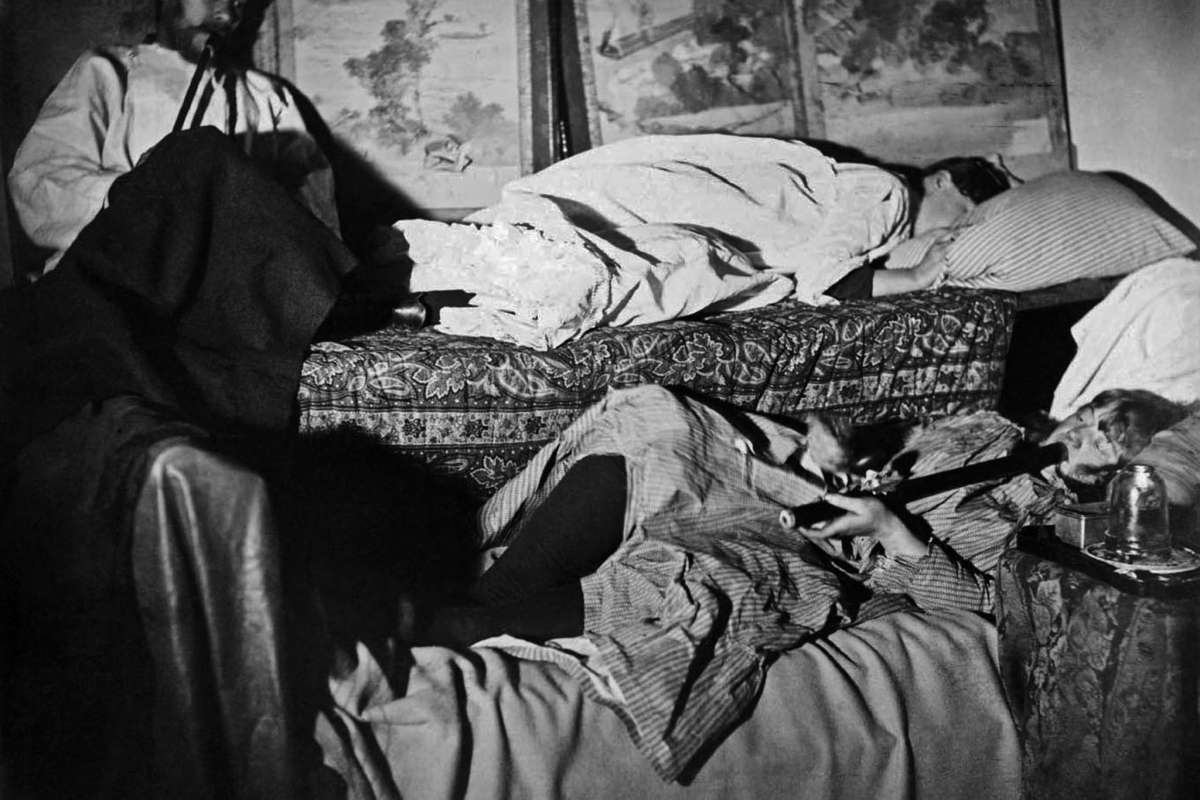
Opium den
Still, there were always newspapers looking to out-sell the competition and intrepid reporters looking to make their mark. In 1870, in an attempt to stem the rash of “slavery” stories in the news, California passed a law banning the kidnapping and importation of Chinese, Japanese, and Mongolian women for purposes of prostitution. It accomplished little more than to push the trade underground.
Coincidentally, the term “shanghaied” referring to men and boys who were drugged or otherwise tricked, only to end up on ships far out at sea where they were forced to work as sailors, originated around this time. As the word suggests, many ships were destined for Shanghai; beatings and rape came with the territory. The practice flourished in the port cities of San Francisco and Seattle, as well as Liverpool and London. Life was cheap, but for procurers it was often quite profitable.
Like their shanghaied counterparts, the ironically named “daughters of joy” were simply chattel to be sold, traded, exploited. 14 was considered the optimal age for Chinatown’s “working girls,” though some were as young as seven or eight. Conveniently, when California introduced its penal code in 1850, the age of consent was set at 10. Needless to say, laws designating 10-year-old girls as mature enough to make informed decisions, least of all about their bodies, were determined and enacted entirely by men. (Childhood in the 19th century was a potential nightmare for any member of the working class, regardless of ethnicity. Prior to 1918, it was legal, in the US, for children as young as four to work highly dangerous, 14 and 16-hour days in coal mines, textile mills and glass factories.) As for rape, female virginity was considered a pre-condition. So, legally a female could only be raped once in her lifetime.
14 was considered the optimal age for Chinatown’s “working girls,” though some were as young as seven or eight.
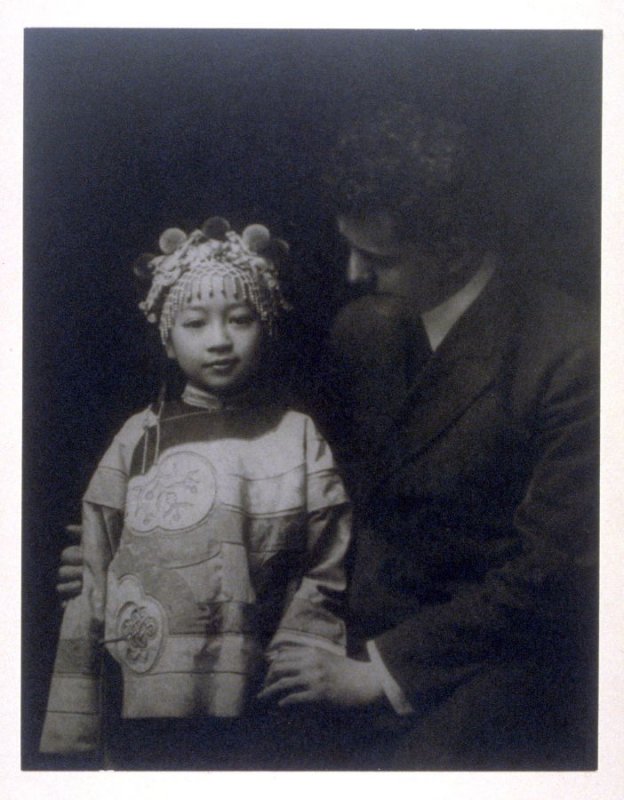
A rescued Chinese child prostitute
Along with being subject to constant psychological and emotional trauma, liberally laced with physical abuse (from both “owners” and clients), Chinatown’s prostitutes were prone to tuberculosis, venereal disease, measles, influenza, tonsillitis, whopping cough, chicken pox, not to mention the complications of pregnancy and botched abortions, all exacerbated by poor diet, questionable hygiene, overcrowding and poor sanitation. Leprosy and smallpox were not unknown. Medical care consisted of traditional herbal remedies; local hospitals shunned “rice eaters” and other colored minorities, for fear of contamination.
Those who became ill were often left to die in squalid rooms, their corpses abandoned in alleyways. The neighborhood’s death rate was, not surprisingly, said to be double that of the rest of the city. According to Julia Flynn Siler, author of The White Devil’s Daughters: The Women Who Fought Slavery in San Francisco’s Chinatown, the average longevity of girls, once conscripted “into service,” was four years. A Chinese harlot of 20, noted Ashbury, “was a great rarity.”
The average longevity of girls, once conscripted “into service,” was four years. A Chinese harlot of 20, noted Ashbury, “was a great rarity.”
Meanwhile, both Methodist and Presbyterian societies were competitively vying to “save heathen souls” — though they were, arguably, less concerned about the “sin,” slavery and squalid circumstances of Chinatown’s “blossoms” than about enlarging the ranks of religious converts.
Do-gooders attempting to fight involuntary indenture knew, full well, that human trafficking was inexorably connected to corruption at the highest levels of city government, and that the financial kickbacks were enormous. Their efforts were further frustrated by the calculated changing of brothel street names and building numbers. A fresh coat of paint, or hiring a white watchman to be on the lookout, was sometimes enough to do the trick.
Even powerful local Chinese civic organizations, like the Six Companies and the Chinese Native Sons, which sought to end the trade, risked being targeted, with Tong death threats plastered, for all to see, on the facades of Chinatown’s buildings.
Potential escapees (most of whom were illiterate and spoke no English) were fed stories about the horrors that awaited them under Mission House “protection:” locked into tiny rooms, starved, beaten, their blood drunk in bizarre religious ceremonies (e.g. Catholic communion) by white heathens — a fate that most (excluding the blood-drinking part) were already well familiar with. Those who did manage to find refuge were under constant threat of being kidnapped by Chinese gang members, and sometimes by virulently anti-Chinese Irish, who saw themselves in competition with local Asians for jobs. Even attending church on Sunday was risky.
The Tongs had quickly learned how to work the system. Each “daughter of joy” signed a formal contract (a fingerprint would do) that, if need be, could be presented as evidence that they’d entered their profession of their own free will, though that was rarely the case. When a girl (they were mostly in their teens) went missing, the Tongs would hire a white lawyer who would have her arrested on invented charges or block her departure (aided by bribed police officers), then have the girl released back into Tong custody.
Some escapees had murder contracts taken out on them, as well as on anyone thought to be helping them. These contracts, like those issued against the aforementioned civic organizations, were posted on the walls of Chinatown’s buildings for all to see. Another trafficker ruse was accusing a Mission runaway of theft, then trying to retrieve his “property.”
Wealthier white families sometimes employed “a little Chinaman” (to handle laundry, cooking and other tedious, time-consuming chores), or mui tsai (unpaid servant girls, rationalized as a form of charity); some were well-treated, others were beaten or worse. But few bustle-and-bonnet-clad, mustached-and-carefully-tailored Victorians seemed to question that, unlike their own daughters, Chinatown’s “blossoms” hadn’t chosen their fate or didn’t deserve to live in squalor and be molested by as many as a dozen strangers a day. Prostitution remained legal, after all. Besides, digging into such unseemly corners might reveal things that proper Victorian wives would prefer not to know. Who, for instance, might be frequenting those “dens of iniquity” – a husband, a son, brother, a father?
Who, for instance, might be frequenting those “dens of iniquity” – a husband, a son, brother, a father?
Better just to look away.
***
Traffickers carefully coached their “cargo” on how to answer immigration official’s questions. (The literate were given detailed booklets to study on the passage over, which they were instructed to burn or throw overboard before landing.) Others had their hair cut off and were dressed as boys. Still others were hidden inside padded crates of dishware and billed as freight. Customs officials were, of course, liberally bribed.
They arrived by the shipload into San Francisco’s harbor. At first auctions, like those Africans had endured upon arriving at Eastern and Caribbean ports, were held openly in full view of curious crowds, the girls stripped naked and inspected to ascertain their virginity and beauty. Occasionally, one would be purchased by a well-to-do merchant as a “wife.” Local police, their pockets lined with under-the-table lucre, were happy to help escort “the load of human freight” as one newspaper put it, from the ships to their final destinations.
When the Chinese Exhibit, part of San Francisco’s Midwinter Fair of 1884, was in the planning stages, Little Pete (a notorious Chinatown gangster with a network of procurers inside China) arranged (with help from the US Congress) to have hundreds enter the country with papers claiming they were actors, acrobats and other exhibit performers. The ruse worked again for the 1898 Omaha Exposition.
Merchants, like performers, were among the few who could bypass the Exclusion Act, a loophole that was quickly seized upon. On September 21, 1889, the New York Times announced the arrival of 24 Chinese females in San Francisco’s port carrying papers declaring them merchant wives and daughters:
They are, however, nothing of the sort…The Chinese slave trade is a growing business. Girls are brought from their parents for $100 to $300 on the promise that they will be brought here and married. On their arrival they pass through the habeus corpus mill and are disposed of for $1,500 or $2000 and placed in disreputable houses.
(By this estimate, they were bought, in 2019 currency, for as little as $2,820 (other sources suggest the price was a tenth of that), the youngest and prettiest ultimately “disposed of” for as much as $56,400). An 1894 San Francisco Chronicle expose compared Chinatown’s slave economy to the cruelties depicted in Harriet Beecher Stowe’s Uncle Tom’s Cabin.
***
In 1915, by which time nearly all US states had passed laws that either banned brothels or regulated the profits of prostitution, San Francisco’s Panama-Pacific International Exposition featured an ambitious “Underground Chinatown” exhibit as part of its “Joy Zone.” In contrast to the Expo’s dignified, official Chinese Pavilion, this one advertised the now-familiar temptations of “Opium Den in Full Operation” and “White Slave Girls.” Wax figures depicted bleary-eyed addicts, “Chinese” actors wielded hatchets, actresses portraying whores beckoned from behind barred cages. The brainchild of theatre impresario Sidney Grauman, it proved wildly popular.
Twelve years later, Grauman would literally “cement” his legacy with his eponymous “Chinese” Theatre, a $2,000,000 steel-girded extravaganza complete with imported temple bells, pagodas, Heavenly Dogs, and a unique sidewalk entrance where A-list celebrities vied to leave their handprints and signatures for future generations to admire. Chinese actress Anna May Wong was recruited to drive in the buildings’ first rivet — eerily reminiscent of the Transcontinental Railway’s “Golden Spike” which, 58 years before, had marked the completion of track built almost entirely by Chinese labor.
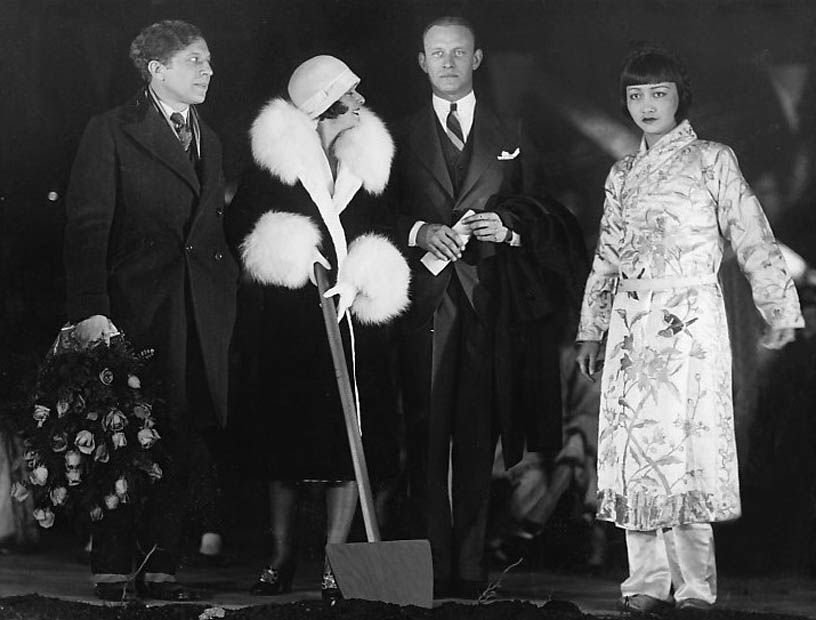
Anna May Wong (far right) at the opening of Grauman’s Chinese Theatre
***
In 1919, D. W. Griffith’s silent melodrama, “Broken Blossoms” (aka “The Yellow Man and the Girl”) was released; it quickly became box office gold. Lillian Gish plays Lucy, a frail, golden-haired teenager living (improbably) in Limehouse — London’s notoriously seedy Chinatown. Abused by her alcoholic father, she’s rescued – temporarily – by Cheng Huan, a sensitive young Buddhist (in the original story, Cheng was a drifter who patronized opium dens and whores) played by a Caucasian. In the film’s famous “closet scene,” Lucy is portrayed as living like a caged animal, an apt analogy for what her real-life counterparts were enduring.
Coincidentally, 1919 was the year Britain’s Parliament voted to extend their 1914 Alien Restriction Act (similar to the US’ 1882 Exclusion Act). Though Griffith intended his film as a protest against violence and a plea for racial tolerance, and though the villain, Gish’s boxer father, was white, the film somehow managed to further promote negative stereotypes.
“Broken Blossoms” was quickly followed by “Limehouse Blues” (1921), a ballad about opium and innocence corrupted, the brainchild of two British composers. (Fu Manchu, a kind of Sino-Dracula whose exploits, in numerous novels, included kidnapping beautiful young white women, plying them with opium, and forcing them into depravity, was another British contribution that reinforced already prevalent Western views.)
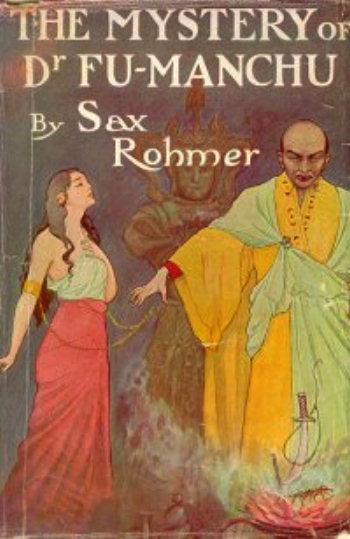
Three years later, the “show stopper” song crossed the Atlantic, catapulting British actress Gertrude Lawrence to stardom when she performed it on Broadway:
Oh, Limehouse kid
Oh, oh, Limehouse kid
Goin’ the way
That the rest of them did.
Poor broken blossom
And nobody’s child
Haunting and taunting
You’re just kind of wild.
Haunting and taunting. The public, it seemed, couldn’t get enough of such lurid, exotic, hothouse fantasies. To the casual observer, it all seemed innocent enough, even charming, not unlike the “Indian head” pennies and nickels being issued by the US Mint now that that country’s “Native American problem” had been dealt with.
Fu Manchu’s fame (augmented by a notoriously sinister mustache) spread from England to the States, joining ranks with “The Yellow Peril,” an epithet coined by William Randolph Hearst’s influential newspapers; Griffith’s film made the reverse journey, then “Limehouse Blues” re-crossed the Atlantic (back to New York, west to California), pollinating and cross-pollinating racist notions.
***
By 1932, the demographics of Chinatown (rebuilt after the 1906 quake and fire) finally shifted, its bachelor society having given way to families, with a population of some 16,000.
The following year, with Prohibition over, the neighborhood was transformed again, this time into a glamorous, neon-illumined nightclub destination — Forbidden City, and the Shangri-La among them — featuring Asian showgirls.
But according to Siler, young girls were still being sold by their parents for $450 and shipped to California, where they fetched ten times as much from local brothel owners. Dressed in lovely embroidered clothes, their long hair unceremoniously chopped off, they were, like their predecessors, quickly set to work, earning their ”owners” as much in one day as a female garment worker earned in a month.
It wasn’t until 1935, following the infamous “Broken Blossom” trial, that things substantially changed; the proceedings hinged, in large part, on the testimony of two brave, former slave girls, neither of whom resembled Lillian Gish. It was the first major conviction of a slave ring operating between China and the US. Four major traffickers were deported.
***
Why dredge up old, unpleasant history? some people inevitably ask. Time to move on. The past is past.
If only.
Between 1932 and 1945, tens of thousands of so-called comfort women, some as young as 12, were forced into sexual slavery in territories occupied by Japan’s Imperial Army, They came from all over Southeast Asia, including the Philippines, but most were Korean or Chinese. Those who hadn’t been sold by their parents had been rounded up on the streets, convinced to travel to what they thought were nursing units or jobs.
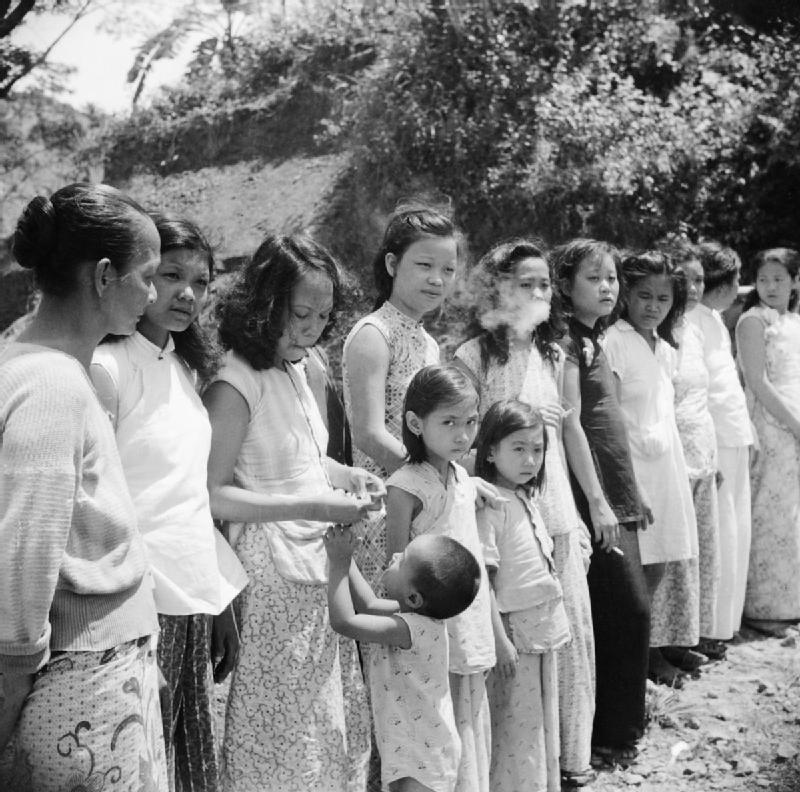
Malaysian comfort women
At war’s end, more than 10,000 (including kidnapped, war-orphaned high schoolers) were forced to service American GIs. Japan’s prime minister saw it as a way to protect “respectable” Japanese women from “mass rape” during the US occupation; US military leaders viewed it as good for troop morale.
According to numbers recently released by the FBI, human trafficking for prostitution is, today, the fastest growing organized crime business and the third largest criminal enterprise in the world. As of January 2018 (this from the International Labor Organization), an estimated 4.8 million, mostly women and girls, were victims of forced sexual exploitation worldwide, along with one million children.
Recent immigrants are particularly vulnerable. And that vulnerability is inextricably linked to attitudes about race.
Recent immigrants are particularly vulnerable. And that vulnerability is inextricably linked to attitudes about race.
Which brings us, unavoidably, to the sitting US president.
His increasing disturbing public record regarding immigration and race, wrote history professor Jelani Cobb, “is reanimating ideas whose prevalence wrecked havoc in the nation’s past.
“The epidermal lottery into which we are all cast” is, for Donald Trump, Cobb continued, “more than happenstance. Pigment is something foundational — a navigational star in the night sky of his world view.”
That “foundation,” central to everything from the abuses of the Antebellum South, the sustained genocide of Native Americans, and the early days of San Francisco’s Chinatown, to this month’s racially motivated mass shootings in El Paso, Texas, is still very much with us.
